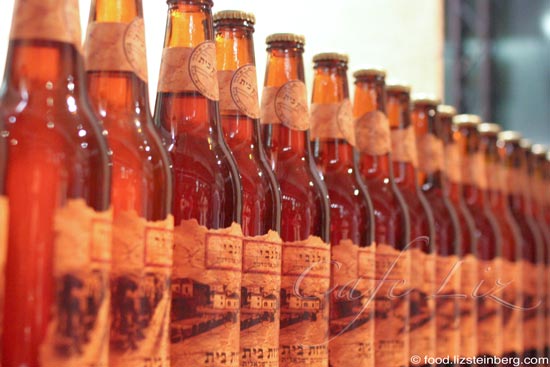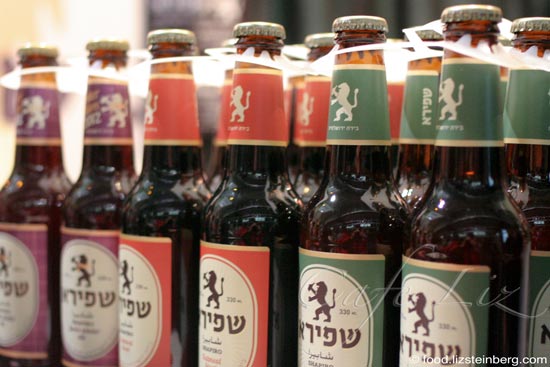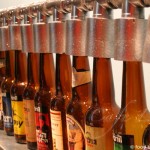What makes a beer Israeli?

Is there such a thing as Israeli beer, and if so, what makes a beer Israeli? I’m not the first person to ask that question, but it comes up again on the occasion of Israel’s second-ever beer expo, Beers 2012.
The local industry is young but growing, with a profusion of microbreweries and home breweries — enough of them to fill a stadium (Nokia Stadium, to be precise). But while the beers are brewed here — even the mass-market Danish brands Carlsberg and Tuborg — nearly all the raw ingredients are imported. The malt — made abroad in a water-intensive process; hops — grown elsewhere, since the plant likes cold weather. In fact, as a liquor store owner disdainfully pointed out to me last year, even the beer styles are imported — Pilsner, Stout, Lager, Ale, Tripel. (Of course, the same could be said for “local” beers from many countries, but that’s not our focus here.)
Now, unlike that liquor store owner, that doesn’t mean that most of us intend to refrain from drinking locally-produced craft beers because there’s nothing distinctly Israeli about them. What it means is that coming up with a truly local, Israeli product is difficult. It demands creativity.
It’s not simply a matter of suiting a beer to the local market. The drinking culture here is relatively undeveloped — Israelis drink an average of 13 liters of beer per year, versus 85 for Americans, 99 for the British and 158 for the Czech, the world leaders — so you can’t really say there’s a beer with a specifically Israeli taste. (Not that Israelis are big drinkers in general: They’re 140th in the WHO’s ranking of alcohol consumption by nation, between Ghana and Djibouti, and close to a large block of predominantly Muslim countries.)

Not all the breweries make “Israelifying” beer their focus — there are plenty that just try to make beer they like. But plenty of others evince conceptual awareness, labeling some of their products specifically “Israeli.” For most breweries, the “Israeli” twist comes through flavorings such as pomegranate, mint or orange peel, all of which are locally grown. Sure, these kinds of additions may make purists cringe, but let’s not be snobs — if it tastes good, what’s the problem?
I’d made a list of “Israeli”-style beers I’d been hoping to try — Butterfly’s pomegranate beer, Herzl’s seven species beer and Binyamina’s watermelon beer, among others — but with the exception of Lone Tree and their pomegranate-date beer, none of these breweries were actually at the expo this year. (About that pomegranate-date beer — it’s a very strong, bitter pale ale that gets a second fermentation with pomegranate juice and date syrup. They said the fruit flavors show up on the aftertaste, but I couldn’t really taste them.)
So that left the breweries making beer for the fun of making beer, of which there were lots.
There were about four dozen local breweries to choose from, many of them looking to build a name for themselves and find customers. I skipped the ones I knew, even those whose beers I particularly like, in the name of finding something new and interesting.

Some were truly spectacular. That’s what I said about Bazelet’s beers after last year’s expo, and I’d say that Bazelet certainly has broken into the market since then. Let’s see if the same happens for the following beers.
Shapiro’s Jack winter ale — this amber beer has a pleasant hops and malt flavor, and the infusion of Jack Daniels-soaked oak adds a lovely wood essence, perfect for people like me who find whisky to be too alcoholic. Miriam and I both agreed that this was one of the best beers we tasted, if not the best. Their pale ale was also excellent. (In the photo above.)
Galil’s pumpkin ale and pale ale. I liked the pumpkin ale, an amber ale infused with cooked pumpkin and spices. It reminded me of pumpkin pie. The brewery’s pale ale, which they describe as American-style, was also enjoyable. (Top photo.)
In short, those are two breweries to look out for.
I also liked the light bitter beer from Libira, which is actually a brewhouse-restaurant in Haifa, and the slightly spicy blond ale from Malka, which has definitely established itself in the local scene already. My cousin-in-law’s Berliner Weiss beer was also notable — this interesting variety contains very little hops and strong natural acidity from bacteria, which makes it almost like an unsweetened lemonade. But he’s brewing primarily for fun; don’t expect to see that one in the market anytime soon.
So, what does make a beer Israeli? That’s something we’ll have to see as the market develops.

Apple cider makes an intro
Also breaking into the local scene this year was hard apple cider — which, unlike beer, is made entirely with local products. Tura, Sideffect and Isra-Ale all were presenting ciders at the expo.
Once again, Isra-Ale wins the naming contest — its two ciders are called ’48 and ’67 (Irreverent names are apparently the new big thing in alcohol, and it’s no surprise this would take a political twist here).
My favorites were Isra-Ale’s ’67, made from Granny Smith and Golden Delicious and the drier of the brewery’s two ciders, with 6.7% alcohol — hence the excuse for the name — and Sideffect’s sweeter cider (surprisingly), made from a blend of half a dozen apple varieties.
And speaking of adapting drinks to local tastes, Isra-Ale’s Denny Neilson said that his sweeter cider, the ’48, appeals more to people who aren’t familiar with hard cider — namely, the Israeli market. So there you have it.



